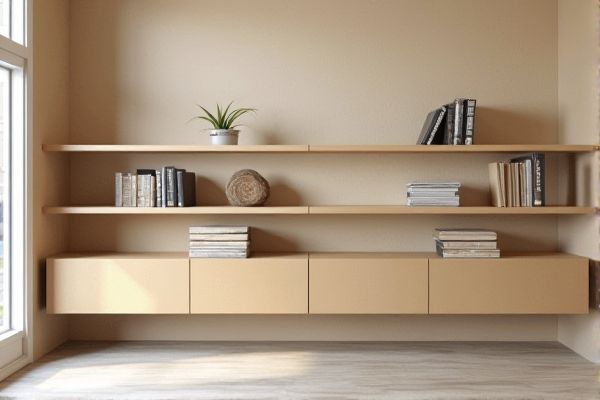
MDF shelves provide a smooth surface ideal for painting and are generally more affordable, while plywood shelves offer superior strength and better moisture resistance, making them more durable for heavy loads. Discover which material best suits Your storage needs by reading the rest of the article.
Table of Comparison
| Feature | MDF Shelves | Plywood Shelves |
|---|---|---|
| Material Composition | Engineered wood made from wood fibers and resin | Made from layers of thin wood veneer glued together |
| Strength & Durability | Medium strength; prone to sagging under heavy weight | High strength; resists warping and sagging |
| Moisture Resistance | Low; susceptible to swelling when wet | Moderate; better moisture resistance with proper sealing |
| Surface Finish | Smooth surface ideal for painting and laminates | Natural wood grain visible; takes stains and varnish well |
| Weight | Heavier than plywood | Lighter compared to MDF |
| Cost | Generally lower cost | Usually higher cost |
| Best Use | Indoor shelves with light to moderate load | Shelves requiring strength, durability, and moisture resistance |
Introduction to MDF and Plywood Shelves
MDF shelves are made from medium-density fiberboard, a composite material crafted by compressing wood fibers with resin, resulting in a smooth, uniform surface ideal for painting and finishing. Plywood shelves consist of multiple thin layers of wood veneer glued together, providing enhanced strength, durability, and resistance to warping compared to MDF. Your choice between MDF and plywood shelves depends on factors like load-bearing needs, moisture exposure, and desired finish quality.
Material Composition and Manufacturing
MDF shelves are made from finely ground wood fibers combined with resin and wax, pressed under high heat to create a dense, smooth surface ideal for painting. Plywood shelves consist of multiple thin layers of wood veneers glued together with the grain of each layer oriented perpendicular to the adjacent one, offering superior strength and resistance to warping. Understanding the material composition and manufacturing process helps you choose shelves that best suit your durability and finish requirements.
Strength and Durability Comparison
MDF shelves offer a smooth surface and uniform density but lack the structural strength and moisture resistance found in plywood shelves, making plywood more durable for heavy loads and humid environments. Plywood's cross-laminated layers provide superior resistance to warping, bending, and splitting, enhancing its longevity under stress. For applications requiring strength and long-term durability, plywood shelves outperform MDF in maintaining structural integrity over time.
Cost Differences: MDF vs Plywood
MDF shelves typically cost less than plywood shelves due to the cheaper manufacturing process and material composition of MDF, which consists of compressed wood fibers and resin. Plywood shelves, made from thin layers of wood veneer glued together, generally provide superior strength and moisture resistance, explaining their higher price point. For your project, choosing MDF can be budget-friendly but may compromise durability compared to more expensive, robust plywood options.
Aesthetic and Finish Options
MDF shelves offer a smooth, uniform surface ideal for painting and veneering, providing a consistent finish that enhances modern and sleek aesthetics. Plywood shelves display natural wood grain, offering a warm, textured appearance favored for rustic or traditional designs. Your choice depends on whether you prioritize versatile finishes with MDF or the authentic wood look of plywood shelves.
Ease of Installation and Workability
MDF shelves offer superior ease of installation due to their uniform density and smooth surface, which allows for precise cutting and drilling without splintering. Plywood shelves provide greater workability, especially for structural applications, as their layered construction resists warping and can hold screws securely. Both materials accommodate common fastening methods, but MDF is preferable for intricate designs, while plywood excels in durability and strength during installation.
Resistance to Moisture and Environmental Factors
MDF shelves are more prone to swelling and warping when exposed to moisture due to their wood fiber composition and glue binding, making them less suitable for humid environments. Plywood shelves exhibit superior resistance to moisture and environmental factors as their layered veneer construction provides enhanced strength and dimensional stability. For areas subject to fluctuating humidity or direct moisture exposure, plywood is the preferred material for long-lasting, durable shelving solutions.
Weight Capacity and Load-Bearing Analysis
MDF shelves typically have lower weight capacity compared to plywood shelves due to their denser but more brittle composition, making them less suitable for heavy or load-bearing applications. Plywood shelves, constructed from multiple layers of cross-laminated wood veneer, provide superior strength and resistance to warping, supporting heavier loads effectively in both residential and commercial settings. Load-bearing analysis confirms plywood's advantage in durability and structural integrity, especially in environments requiring consistent weight support over extended periods.
Sustainability and Environmental Impact
Plywood shelves generally have a lower environmental impact compared to MDF shelves due to their use of real wood veneers, which can be sourced from sustainably managed forests and are biodegradable. MDF shelves often contain formaldehyde-based resins and rely on wood fibers bonded with synthetic adhesives, raising concerns about indoor air quality and recyclability. Choosing FSC-certified plywood shelves supports sustainable forestry practices, reducing deforestation and promoting responsible resource management.
Final Verdict: Choosing the Right Shelf Material
MDF shelves offer a smooth surface ideal for painting and are cost-effective but can be less durable and susceptible to moisture damage compared to plywood shelves, which provide superior strength, stability, and resistance to warping. Your choice depends on the environment and intended use; plywood is better suited for high-load or humid areas, while MDF works well for decorative, low-stress applications. Consider the specific needs of your space and budget to select the right material for lasting performance and aesthetic appeal.
 homyna.com
homyna.com